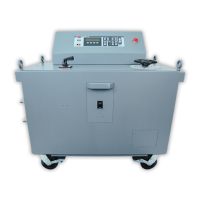I:·
I .
)
I
i.
I
3. MAINTENANCE OF PROTECTIVE APPARATUS MAINTENANCE OF MOTOR
OVERLOAD
RELAYS
APPLICATION:
The primary function
of
the motor overload relay is to prevent operation
of
a motor for
too long a period
of
time to prevent damage to that motor when an overload condition
exists.
In
general, motor starters are applicable to a given horsepower range
of
motors. The
. voltage and current requirements
of
the application will "size" the starter under NEMA
requirements, but the actual starting current, running current, ambient temperature and
severity
of
atmospheric conditions will determine the overload relay rating required to
protect the motor without nuisance tripping.
Selection
of
the properly rated overload relay heater or coil can be made by reference
to tables
or
charts supplied by the manufacturer
of
the overload relays. Whenever a
motor trips out it is poor practice to indiscriminately install a larger heater or coil, since
the motor may actually be working under an overload condition
or
the overload relay
may be operating improperly. Installing a larger heater
or
coil could allow an
overloaded motor to continue to run, resulting in deterioration
of
the motor insulation
and reduction
of
motor life. Therefore, careful analysis should be made as to the cause
of
the trip before changing the rating
of
the overload relay heater. Operating
characteristics
of
the motor overload relay should be verified at regular intervals. The
inspection and test interval can vary widely depending on the type
of
service involved,
the importance
of
the motor to process or production, and environmental conditions.
TYPES:
Motor overload relays incorporate an element which actuates a set
of
contacts
connected to the motor control circuit. These contacts open the circuit
of
the holding
coil
in
the motor starter and interrupt the power to the motor.
In
general, there are three types
of
motor overload relays in use:
1.
Thermal - melting alloy or solder pot
2.
Thermal - bimetallic strip
3.
Electromagnetic
In
thermal type relays, time-current characteristics are obtained by the thermal
properties
of
the
melting alloy
or
bimetallic strip. In the magnetic type, a damped
plunger
or
moving iron device is used to produce time delays.
1. Thermal - melting alloy or solder pot:
In this type, tripping is the result
of
heat generated by the motor overload current
passing through a "heater"
in
the overload relay. This overload relay consists
of
a
brass shaft which is surrounded by solder. Fixed to one end
of
the shaft is a small
ratchet wheel. As long as the solder is solid, this assembly is immobile. When the
motor control circuit contacts are closed, a spring in the motor overload relay is held
26

